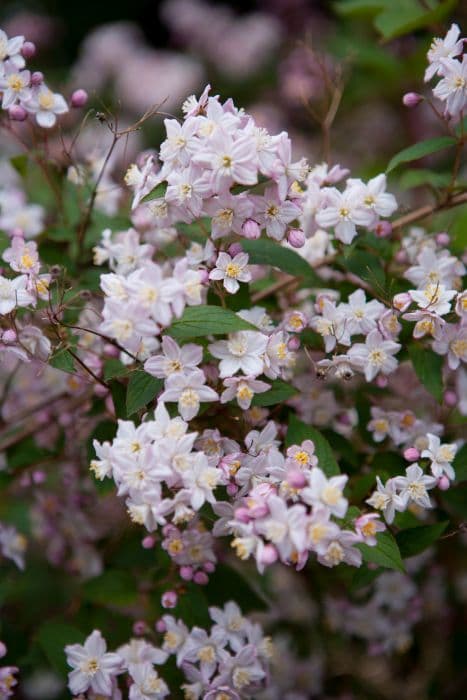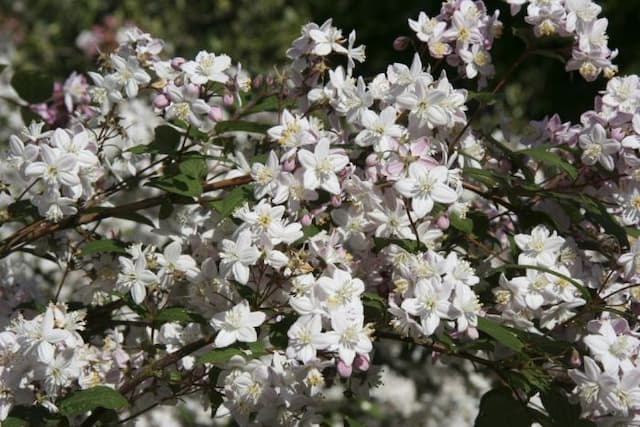Lacecap Hydrangea Hydrangea macrophylla 'Lanarth White' (L)

ABOUT
Hydrangea macrophylla 'Lanarth White' is a striking plant known for its beautiful blooms. The flowers appear in rounded clusters, often referred to as mopheads, which are a hallmark of this type of hydrangea. The name 'Lanarth White' suggests that the flowers would be pure white, but in reality, the blossoms may have a subtle blue or pink hue depending on the soil pH. The mopheads are composed of numerous small individual flowers that give a lush, full appearance. These flower clusters bloom profusely, creating a striking contrast against the backdrop of the plant's rich green foliage. The leaves are large, with a somewhat oval shape and a pointy tip, boasting toothed edges that give them a slightly serrated look. The texture of the leaves is somewhat thick and leathery, with a shiny surface that catches the light. While the main attraction is unquestionably its spectacular blooms, even when not in flower, the plant offers a lush green presence in the garden. Without specifying its size, the spread of the plant is generous, allowing for an impressive display of its beautiful mophead flowers and glossy leaves. The stems are sturdy, supporting the weight of the blooms well throughout the flowering season. Hydrangea macrophylla 'Lanarth White' can act as a standout specimen in a garden or serve as part of a larger design, mingling with other plants. The ability of the flowers to subtly change color based on the soil's acidity or alkalinity adds an extra element of surprise, as the blossoms can shift in shades over the season or in different soil conditions. It's a plant that invites gardeners to appreciate the nuances of nature's palette, providing a serene and elegant visual experience.
About this plant
 Names
NamesFamily
Hydrangeaceae.
Synonyms
Lanarth White Hydrangea, Bigleaf Hydrangea, French Hydrangea, Lacecap Hydrangea.
Common names
Hydrangea macrophylla (Thunb.) Ser.
 Toxicity
ToxicityTo humans
Hydrangeas, including the 'Lanarth White,' contain compounds called cyanogenic glycosides, which can release cyanide when chewed or digested. If ingested, this plant can cause mild to moderate symptoms such as nausea, vomiting, and diarrhea. In some cases, ingestion can lead to more serious symptoms, including dizziness, confusion, and an increased heart rate. It's important to seek medical attention if symptoms occur after ingesting parts of a hydrangea.
To pets
Hydrangeas, like 'Lanarth White,' are also toxic to pets due to the presence of cyanogenic glycosides. If a pet ingests hydrangea leaves, buds, or flowers, it could exhibit symptoms such as vomiting, diarrhea, lethargy, and depression. In more severe cases, ingestion can cause confusion, cardiovascular collapse, and seizures. It’s important to contact a veterinarian immediately if you suspect your pet has ingested hydrangea plant material.
 Characteristics
CharacteristicsLife cycle
Perennials
Foliage type
Deciduous
Color of leaves
Green
Flower color
White
Height
3-6 feet (0.91-1.83 meters)
Spread
3-6 feet (0.91-1.83 meters)
Plant type
Shrub
Hardiness zones
6
Native area
Japan
Benefits
 General Benefits
General Benefits- Ornamental Value: Adds aesthetic appeal to gardens with its large, snowy white blooms and lush foliage.
- Shade Tolerance: Grows well in partially shaded areas, making it a versatile choice for various garden spots.
- Seasonal Interest: Provides spring and summer interest with its flowers, and some leaf color change in fall.
- Attracts Wildlife: Blossoms can attract butterflies and other pollinators, contributing to local biodiversity.
- Soil Adaptability: Can adapt to a range of soil types, although it prefers moist, well-drained soil.
- Garden Design: Useful for borders, hedges, or as a focal point due to its distinctive blooms and structure.
- Cut Flowers: Its large, showy blooms make excellent cut flowers for arrangements inside the home.
- Rustic Charm: Adds a traditional or cottage garden feel to the landscape.
- Relative Hardiness: Capable of withstanding cooler temperatures once established, up to USDA Zone 5.
 Medical Properties
Medical PropertiesThis plant is not used for medical purposes.
 Air-purifying Qualities
Air-purifying QualitiesThis plant is not specifically known for air purifying qualities.
 Other Uses
Other Uses- In Japan, certain types of Hydrangea are used to sweeten tea, though it is important to ensure that the plant is safe for consumption before trying this.
- Artistic Inspiration: Artists and photographers frequently use the intricate flowers of the Hydrangea as subjects for their work, capturing their beauty in different mediums.
- Symbolism: Hydrangeas often symbolize gratitude, grace, and beauty, and can be given as gifts to express these sentiments.
- Dye: The flowers of the Hydrangea can be used to naturally dye fabric or paper, often resulting in shades of blue, purple, or pink, depending on the pH of the soil the plant was grown in.
- Educational Resource: Horticulture students and plant enthusiasts use Hydrangeas to study the effects of soil pH on flower color.
- Water Indicator: Hydrangeas can serve as a natural indicator of soil moisture due to their high water demand, as they wilt when they need watering.
- Seasonal Decorations: Dried Hydrangea flowers can be used in wreaths or arrangements to create rustic and long-lasting decorations.
- Crafts: Fresh or dried Hydrangea blooms can be incorporated into a variety of crafts, such as making bookmarks or pressed flower art.
- Horticultural Training: Pruning Hydrangeas effectively requires skill, making them an ideal subject for training novice gardeners.
- Weddings: The attractive blooms of Hydrangeas are commonly used in wedding bouquets and venue decorations due to their full, lush appearance.
Interesting Facts
 Feng Shui
Feng ShuiThe Hydrangea is not used in Feng Shui practice.
 Zodiac Sign Compitability
Zodiac Sign CompitabilityThe Hydrangea is not used in astrology practice.
 Plant Symbolism
Plant Symbolism- Heartfelt Emotions: Lanarth White hydrangeas, like other hydrangeas, often represent genuine, deep-rooted feelings and can be given to express sincere emotion.
- Gratitude: The full, round blossoms symbolize abundance and gratitude, making the plant suitable for thank you gestures or to show appreciation.
- Understanding: With their peaceful color, Lanarth White hydrangeas are thought to convey a message of understanding and patience.
- Apology/Remorse: Sometimes hydrangeas are used to apologize, as they can also symbolize regret or a desire for reconciliation.
- Boastfulness or Vanity: In certain cultural contexts, hydrangeas may carry a negative connotation, symbolizing boastfulness or vanity due to their showy and abundant flowers.
- Beauty: The delicate white flowers of the Lanarth White hydrangea are often associated with claims of beauty and gracefulness.
 Water
WaterMophead hydrangeas, such as 'Lanarth White', should be watered deeply once a week, with about 1 gallon of water per session during active growth periods in the spring and summer. In hotter climates or during periods of drought, they may require additional water to maintain moist soil. During the fall and winter when the plant is dormant, reduce watering to every other week, providing only enough water to prevent the soil from drying out completely. It's important to avoid overhead watering to keep the flowers and leaves dry and prevent fungal diseases.
 Light
LightMophead hydrangeas prefer bright, indirect sunlight or partial shade. They thrive best when planted in a spot that receives morning sunlight and afternoon shade, particularly in regions with hot summers. Direct afternoon sunlight can cause leaf scorch, so it's essential to ensure the plant is protected during the hottest part of the day.
 Temperature
TemperatureMophead hydrangeas like 'Lanarth White' do well in a wide range of temperatures but prefer an average of 65 to 75 degrees Fahrenheit. These plants can tolerate minimum temperatures down to about 50 degrees Fahrenheit, while their maximum temperature threshold is around 80 degrees Fahrenheit. However, they can survive short periods outside of these ranges without significant harm.
 Pruning
PruningMophead hydrangeas like 'Lanarth White' benefit from pruning to remove dead wood and encourage bushier growth with more blooms. They should be pruned immediately after flowering since they bloom on old wood. Do not prune in late summer, fall, or winter, as this will remove the next season's flower buds. Pruning should be limited to cutting back the flowering stems to the next bud and removing any dead or crossing branches.
 Cleaning
CleaningAs needed
 Soil
SoilHydrangeas prefer well-draining, rich, loamy soil with a pH of about 5.5 to 6.5 to thrive. A soil mix containing a blend of peat moss, compost, and perlite or vermiculite works well. The slightly acidic pH helps the 'Lanarth White' hydrangea maintain healthy growth and luscious blooms.
 Repotting
Repotting'Lanarth White' hydrangeas generally need repotting every 2 to 3 years, or when the root system becomes crowded. Spring is the ideal time to repot this plant to minimize stress and encourage robust growth throughout the growing season.
 Humidity & Misting
Humidity & Misting'Lanarth White' hydrangeas flourish best in environments with moderate to high humidity levels; aiming for about 60% relative humidity is beneficial for this variety of hydrangea.
 Suitable locations
Suitable locationsIndoor
Place in bright, indirect light and maintain high humidity.
Outdoor
Partial shade, sheltered spot, moist soil, mulch well.
Hardiness zone
6-9 USDA
 Life cycle
Life cycleThe life of a Hydrangea macrophylla 'Lanarth White', commonly known as Lanarth White Hydrangea, begins with seed germination, occurring in a warm, moist soil environment. After sprouting, the seedling grows into a juvenile plant, developing a root system and foliage. As it matures, the hydrangea enters a vegetative stage, producing lush green leaves and stems, with adequate water and light conditions crucial for its growth. The reproductive phase follows, typically starting in late spring or early summer, when the plant forms large, white lacecap flower heads, attracting pollinators and sometimes resulting in seed production. After blooming, the hydrangea enters a period of dormancy in the fall or winter, where growth slows and the plant prepares to survive colder temperatures. With the return of favorable conditions in spring, the plant resumes growth, completing its perennial cycle.
 Propogation
PropogationPropogation time
Spring-Early Summer
The most popular method of propagating the Hydrangea, specifically the Hydrangea macrophylla 'Lanarth White', is through softwood cuttings. This technique is typically carried out in the late spring or early summer when the plant’s new growth is still tender and green, but sufficiently mature to sustain itself. To propagate, one should cut a 4 to 6 inch (10 to 15 cm) length of stem from a healthy branch of the Hydrangea, making sure it includes at least one leaf node. The lower leaves are then removed and the base of the cutting may be dipped in a rooting hormone to encourage root development. The cutting should be planted in a well-draining potting mixture and kept in high humidity and indirect sunlight. Within a few weeks, the cutting will develop roots and can eventually be transplanted outdoors.







![Hydrangea [Early Sensation]](/_next/image?url=https%3A%2F%2Fplants-admin.emdemapps.com%2Fimages%2Fplants%2F%2Fimages%2F604b6150338db.png&w=640&q=75)

